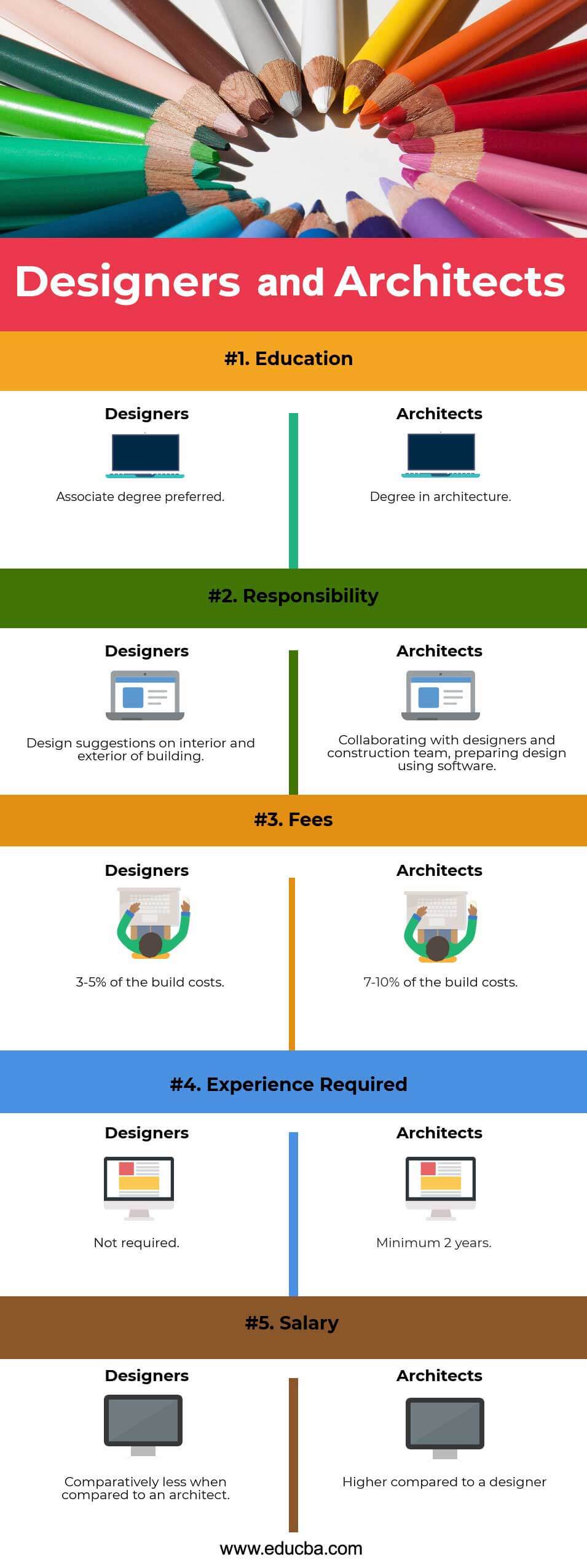Updated May 23, 2023
Differences Between Designers and Architects
Many would not know the difference between an architect and a building designer. Both jobs are designing buildings, residences, factories, and other structures. However, if you look closely at the skills and the services they offer, you could find many differences between them. Based on the skills and qualifications of practicing individuals, a clear-cut distinction between the two professions can be determined. A building designer’s primary duty is to develop designs and drafts of the building structure.
A building designer would meet the client and discusses their requirements and suggestions to incorporate into the design of the building. Based on this, the designer comes up with drafts and concepts of the building. Next, the architect takes on these concepts and determines whether it meets the building specifications regarding the project’s feasibility, functionality, and practicality. Now let us look at the below comparison table to identify the basic difference between Designers and Architects.
Designers and Architects (Infographics)
Below is the top 5 difference between designers vs architects:
Key Differences between Designers and Architects
Below are the lists of points that describe the key differences between designers vs architects:
Who is an architect?
To be an architect, one must graduate from an accredited institution. Most later pursue a master’s degree and complete the Architect Registration Examination. Architects learn about the artistic process behind building design and are trained to create building specifications. They collaborate with designers, contractors, and building inspectors to ensure that their structure meets all the regulations and codes. They can also handle building construction from its initial face to the final process.
To become a professional architect, one must:
- Obtain a valid degree in architecture
- Should be covered by the required liability insurance
- Must be registered as an architect and be compliant with the local architecture body
Even if a person has several degrees in architecture and many years of professional experience, it is illegal to trade as an ‘architect’ if they are not officially registered as one. Therefore, registration with the government architecture organization outlines an ‘architect’ for qualified and legitimate requirements. Scholastically, architects learn about both the artisanship and the science of building plans in significant profundity.
Architects go through around five years at college, covering technical design, history, and contract law. Graduates are ordinarily required to complete two years of practical work under a registered architect before they are qualified for enlistment as an architect. Depending on the briefs provided by the clients, architects and building designers can apply their ideas to the project. Sometimes they may even act as the contract administrator’ and take care of the entire responsibility of the construction process.
Job responsibilities of an architect include:
Meeting with the clients and discussing the design strategies with the design and construction team members.
- Giving fundamental evaluations of costs, work, and building times.
- Visiting the worksites intermittently to check work and meeting plans.
- Preparing scaled illustrations utilizing freehand art or computer-supported drafting software.
- Stay up to date with zoning laws and guidelines, building trends, and design elements.
Who is a building designer?
Building designers collaborate with architects and should be imaginative in dealing with building design. They should understand customers’ communication and transform those thoughts into innovative structure drafts. It is also essential for them to have a working knowledge of construction regulations and building industry standards. Building designers should also have broad practice in math, physical science, and computer-supported drafting. Designers must be set up to adjust designs as they proceed to be prepared to review drafts relying upon a customer’s need.
Earlier, designers were called draftspeople or draftsmen, which later became designers to mirror their advancing jobs and ranges of abilities. Nowadays, a designer’s job is to design functional, energy-efficient, and frequently impressively stunning homes. Building designers can emerge out of various design-related fields. This comprises individuals with degrees and practices in architecture that are not registered as architects and people with a formal education in design.
Job responsibilities of a building designer include:
- Consulting with clients to determine building use, plans, and size
- Making proposals of the physical form and interiors and devising plans to stay within the spending budget.
- Presenting preliminary and finalized designs
- Helping clients hire contractors and construction companies.
Required qualifications for building designers
Nobody can work as a building designer in many places without qualifications or authorizing prerequisites. These places also do not require registration or licensing as well. While anybody can work as a building designer in such places, it is significant to recall that eventually, their work needs to be compliant with building and planning guidelines, or it just won’t be built.
Comparison Table Between Designers and Architects
Below is the topmost comparison between designers and architects:
| Basis of Comparison | Architect | Designer |
| Education | Degree in architecture | Associate degree preferred |
| Responsibility | Collaborating with designers and construction team, preparing design using software | Design suggestions on the interior and exterior of the building |
| Fees | 7-10% of the build costs
|
3-5% of the build costs
|
| Experience Required | Minimum of 2 years | Not required |
| Salary | Higher compared to a designer | Comparatively less when compared to an architect |
Conclusion
By definition, architectural skills may cover practically any degree and are not manageable to basic certification. One appalling outcome is that there is no simple method to recognize a decent architect other than by their work history, experience, and attitude: certification demonstrates just that the individual has some grip of concept, yet not really of practice.
Whether it is an Architect or a Designer, ideally, you should base your choice on experience, qualifications, accomplishments, and enthusiasm – and search for somebody whose past work meets your requirements. Similarly or more crucial is to find the right person you are sure you can coexist with – significantly if that individual will probably help manage your construction project’s development. You will be working with them for a long time!
Recommended Articles
This has been a guide to the top difference between designers and architects. Here we also discuss the designer’s and architects’ key differences with infographics and a comparison table. You may also have a look at the following articles to learn more –




